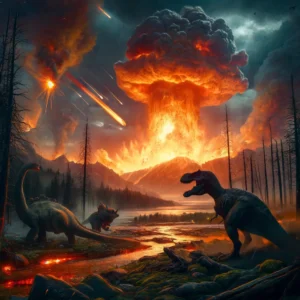Why dinosaurs was extinct
 The extinction of dinosaurs, approximately 66 million years ago, is one of the most significant events in Earth’s history, marking the end of the Cretaceous period and the beginning of the Paleogene period. The most widely accepted explanation is the Cretaceous-Paleogene (K-Pg) extinction event, which involved a combination of catastrophic events. Here’s a breakdown of the main causes believed to have led to the extinction:
The extinction of dinosaurs, approximately 66 million years ago, is one of the most significant events in Earth’s history, marking the end of the Cretaceous period and the beginning of the Paleogene period. The most widely accepted explanation is the Cretaceous-Paleogene (K-Pg) extinction event, which involved a combination of catastrophic events. Here’s a breakdown of the main causes believed to have led to the extinction:
1. Asteroid Impact
The primary theory attributes the extinction to a massive asteroid impact. Evidence includes:
- Chicxulub Crater: A 93-mile-wide impact crater discovered in the Yucatán Peninsula, Mexico, is linked to a massive asteroid about 6 miles in diameter.
- Iridium Layer: A worldwide layer of sediment rich in iridium, a rare element on Earth but common in asteroids, supports this theory.
- Consequences:
- Massive shockwaves and wildfires.
- Global cooling caused by dust and aerosols blocking sunlight (a “nuclear winter”).
- Disruption of photosynthesis and collapse of food chains.
2. Volcanic Activity
Simultaneously, intense volcanic activity in the Deccan Traps in modern-day India contributed to environmental stress. These eruptions released:
- Toxic Gases: Including carbon dioxide (CO₂) and sulfur dioxide (SO₂), leading to acid rain.
- Global Warming: Increased greenhouse gases caused long-term climate changes.
- Ocean Acidification: Harmed marine ecosystems, which were already stressed.
3. Climate and Environmental Changes
The late Cretaceous period experienced significant environmental changes that made ecosystems unstable:
- Sea-Level Fluctuations: Shifting coastlines disrupted habitats.
- Cooling Temperatures: Likely stressed cold-blooded dinosaurs.
- Changing Vegetation: Impacted food availability for herbivorous species, further affecting carnivores.
4. Ecological Fragility
Dinosaurs were the dominant terrestrial vertebrates for over 150 million years, but ecosystems may have become fragile. The combined effects of the asteroid impact, volcanic activity, and climate shifts likely overwhelmed their ability to adapt.
Who Survived?
While dinosaurs went extinct, many other groups survived, such as:
- Birds: Considered modern descendants of theropod dinosaurs.
- Mammals: Diversified after the extinction, leading to the rise of mammals as the dominant terrestrial animals.
- Reptiles, Amphibians, and Fish: Many adapted to the changing environment.
Conclusion
The extinction of dinosaurs was likely caused by a combination of catastrophic events, including an asteroid impact, volcanic activity, and environmental changes. These factors led to a collapse of ecosystems and marked the end of the dinosaurs’ reign, paving the way for mammals and eventually humans to thrive.
This extinction event underscores how sudden and large-scale changes can reshape life on Earth.







